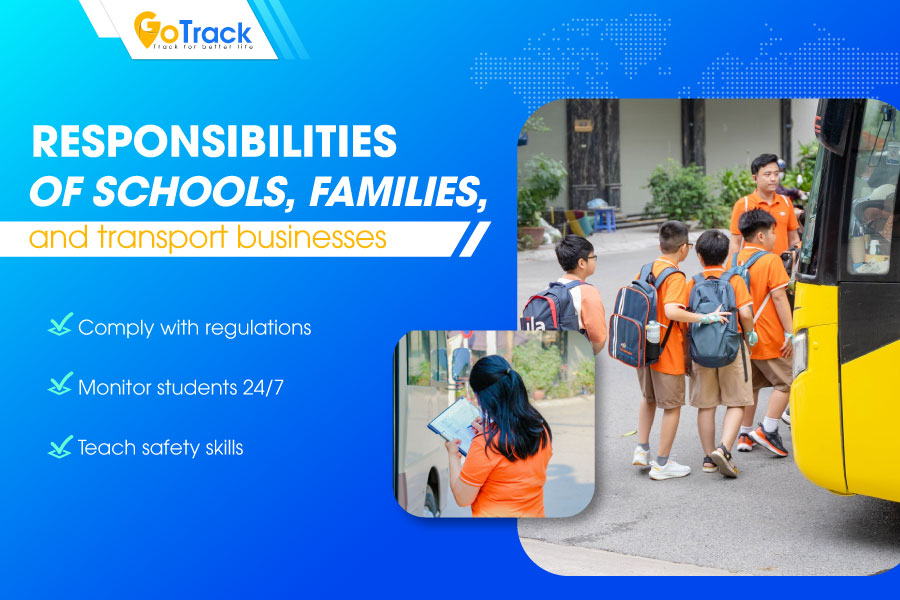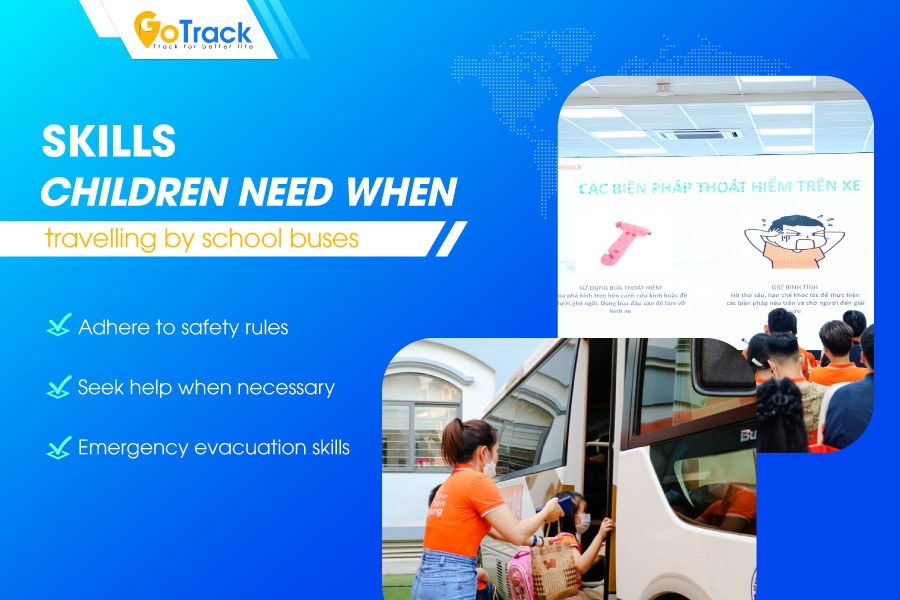School buses are a means of transport that gives parents peace of mind when their children go to school, especially for busy families who do not have the time to drop off and pick up their kids. However, in practice, there have been unfortunate incidents involving school buses, resulting in serious consequences and making many parents anxious. Therefore, families, schools, and transport service providers need to equip children with essential skills and implement measures to ensure the maximum safety of their children when traveling on school buses.
Let’s explore the details with GoTrack in the following article!
Responsibilities of schools, families, and transport businesses
To ensure children’s safety on every trip, close cooperation between the school, parents, and the transport service provider is necessary.
For the school
- Choosing a reputable provider: Firstly, schools need to partner with a professional service provider that complies with legal regulations, such as having the proper business licenses, installing high-tech equipment like cameras or tracking devices on the buses and employing drivers with valid licenses.
- Establishing pick-up and drop-off procedures: To ensure safety and minimize the risk of leaving children on the bus, schools must develop clear procedures for picking up and dropping off children. These procedures should define the responsibilities of staff and should be frequently reviewed, trained, and enforced to ensure compliance.
- Equipping children with safety skills: Schools should regularly organize training sessions to teach children evacuation skills and how to handle emergency situations if they become trapped or face any incidents on the bus.
For classroom teachers
- Monitoring student attendance: Teachers should keep track of students daily and promptly report and contact parents when students are absent without reason. This helps minimize the risk of children being forgotten on the bus without being noticed.

For drivers and staff on school buses
- Managing students: Drivers and bus management staff should adhere to the established procedures, keeping track of the number of students being picked up or dropped off, and closely monitoring students on the bus to reduce risk.
- Emergency escape skills guide: Vehicle managers should provide children with detailed instructions on how to escape in case they are left behind in the vehicle. This includes using the vehicle’s lighting system, alarm, breaking the window, or pressing the help button in case of an emergency.
- Checking the bus after each trip: Drivers and staff should inspect the entire bus after every trip to ensure no child has been left behind.
For the transport businesses
- Ensuring vehicle quality: The school buses must be fully registered and undergo regular maintenance to ensure safe operation.
- Proper equipment: The transport businesses should equip the buses with modern equipment such as GPS tracking devices, cameras for monitoring the driver and students, and child forgetfulness alert systems.
- Supervising drivers and students: Managers must monitor and supervise drivers regularly, promptly address any unsafe behavior, and check the bus to detect if any students have been forgotten.
Read more: Comprehensive technology solutions for school buses
For parents
- Emergency escape skills guide: Teach children how to handle necessary situations when using the school’s transportation service, including emergency responses to seek help from those around them, or key points to remember when trying to contact parents or teachers during dangerous situations.
- Updating information about the child: Parents should keep track of their child’s pick-up and drop-off schedule and maintain communication with teachers and the school to receive timely information and take appropriate action if their child faces any issues.
Important skills when being left in school buses
In dangerous situations, children need to stay calm and identify spots where they can seek help or handle the situation themselves to escape from inside the car:
Open the door next to the driver’s seat: If a child is left behind in the car, they can move towards the front of the car and try to open the door next to the driver’s seat to escape.
Continuously honk the horn at the steering wheel: If the door can’t be opened, the child should try honking the horn at the steering wheel position to attract the attention of people around them.
Press the Hazard emergency lights: In addition, the Hazard lights are a useful tool for seeking help. Press the red triangle button on the car’s control panel, which will activate the warning lights and attract the attention of others.

Break the car window: If the child is stuck in the car for too long without anyone noticing, they should try to break the car window using a specialized window-breaking hammer available in the car or any other available objects. Make sure to apply force to crack the glass while being cautious to avoid injury from broken glass shards.
Use the SOS button – warning horn: Some vehicles used for transporting children are equipped with an SOS button that can trigger a warning signal using lights and sound. If the child is trapped, they should quickly locate the button and activate it to send a signal, helping the driver and others detect the situation in time.



